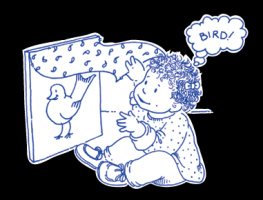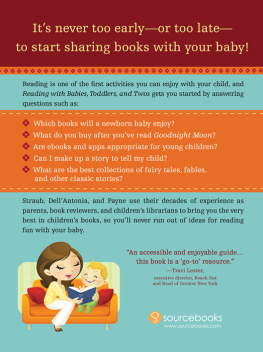
Published by Redleaf Press
10 Yorkton Court
St. Paul, MN 55117
www.redleafpress.org
2013 by Todd Wanerman
All rights reserved. Unless otherwise noted on a specific page, no portion of this publication may be reproduced or transmitted in any form or by any means, electronic or mechanical, including photocopying, recording, or capturing on any information storage and retrieval system, without permission in writing from the publisher, except by a reviewer, who may quote brief passages in a critical article or review to be printed in a magazine or newspaper, or electronically transmitted on radio, television, or the Internet.
First edition 2013
Cover design by Jim Handrigan
Cover photograph Natalia Ulrikh/Veer
Author photograph by Megan London
Interior design by Percolator
Interior photographs by Todd Wanerman, Megan London, Lisa Treadway, and Lindsey Freedman
Illustration shown in photograph 3.4 by Sofia Dillingham
Excerpt from Abiyoyo by Pete Seeger is reprinted with permission of Saga Music, Inc. (BMI)/Figs. D Music (BMI), under license from The Bicycle Music Company. All rights reserved.
Library of Congress Cataloging-in-Publication Data
Wanerman, Todd.
From handprints to hypotheses : using the project approach with toddlers and twos / Todd Wanerman.
p. cm.
Summary: From Handprints to Hypotheses focuses on using the project approacha teaching strategy that enables you to guide children through in-depth studies of real world topicsto scaffold very young childrens early learning. It provides information on creating sensory-based experiencesdevelopmentally appropriate for toddlers and twosthat bring new perspectives and activities into the classroom Provided by publisher.
Includes bibliographical references and index.
ISBN 978-1-60554-246-1 (e-book)
1. Project method in teaching. 2. Early childhood educationCurricula. I. Title.
LB1139.35.P8W36 2013
371.3'6dc23
2012032258
To my own children, and all the artists in my family
To the community of artistschildren and familiesI am privileged to support
To the family of artists, young and old, around the world
Contents
BY CAROLYN POPE EDWARDS
From the very beginning, curiosity and learning refuse simple and isolated things: they love to find the dimensions and relations of complex situations.
Loris Malaguzzi, The Hundred Languages of Children: Narrative of the Possible
In an earlier article, I suggested that projects combine two things that toddlers love dearly: play and investigation. Now, after reading Todd Wanermans book, I would add expression to that set of what is nearest and dearest to toddlers hearts. From Handprints to Hypotheses: Using the Project Approach with Toddlers and Twos is about project-based arts education. The book explains the aims and methods of such an approach and, better yet, takes us inside to see how it might unfold from day to day. It illustrates one North American educators personal interpretation of a Reggio-inspired pedagogy for toddlers with abundant detail and helpful images. Thus, the book suggests one way to implement a project-based arts educationfocusing on childrens emerging expressive capacitiestaking children on a developmental journey from their earliest explorations of materials, where concepts are organized around their perceptions and actions, to long-term inquiries that spring from an idea or question about the materials or about what can be understood through work with materials.
The book and all the stories and vignettes presented also make a strong case for why it even makes sense to undertake projects with this age groupthat is, why it makes sense to engage them in group learning that requires organizing, negotiating, and collaborating and that calls on them to look forward and backward as they work together. All too often, the curriculum for children this age (twelve to thirty-six months) involves simple activities and experiences that come and go with no deep or necessary connection from one to the next. Perhaps because children under three are so obviously immersed in the immediate moment and in the process rather than the product of their activity, teachers and providers may think that they should develop their curriculum without planning emergently or elaborating threads of connection between different learning encounters. Yet such a viewpoint clearly underestimates childrens search for meaning and their drive to discover the dimensions and relations of complex situations, as Malaguzzi describes in the quotation on the previous page.
Who exactly are toddlers and twos anyway? Are they babies? Or are they preschoolers? In fact, there is great professional uncertainty about whether toddler hood is a distinct phase of the life cycle, and this uncertainty bears on why teachers may disagree on how best to support their learning. From a development standpoint, the period bridging infancy and early childhood (between about twelve and thirty-six months of age) is seen as a time of rapid growth and change, yet no consensus exists among the experts about when toddlerhood begins and ends or even about whether it is a full-fledged phase, much less a stage, of the life cycle. Psychologists define a stage as a distinct time of development bounded by fundamental reorganizations in cognitive and social-emotional capacities and characterized by a unique pattern of developmental issues, tasks, and achievements. Toddlers and twos are children making their way between infancy and early childhood, but they look more like a mix of both stages than something categorically distinct from them. Thus, some child development textbook authors divide their material on childhood into three major periods: infancy, early childhood, and middle childhood. In contrast, others treat infancy and toddler hood as two separate periods prior to early childhood. When authors blend toddlerhood into infancy, they tend to place the boundary age marking the transition to early childhood at twenty-four months. But when they treat toddlerhood as a separate period, they tend to move the boundary age forward to the middle or end of the third year, at thirty or thirty-six months. Whichever approach they take, psychologists tend to describe certain kinds of tasks as salient to children in their second and third years of life: achieving autonomy and independence, forming a self-concept, mastering impulses and regulating emotions, and becoming prosocial and oriented to rules and standards of the community.
Todd Wanerman, thankfully, does not bother with this academic controversy but shows us through his examples and his sequence of chapters that he intimately understands the highly individualized ways that children face their life tasks. For example, children are becoming self-reliant and concentrated in their play, or they are overcoming fears of messy materials or dangerous-seeming stimuli. Toddlers also grow and change in their approach to materials from age one to age three, in a way captured by Wanermans shorthand phrase from handprints to hypotheses. I found it very helpful to think about how projects focused on younger toddlers involve more open-ended sensory exploration of how their hands and bodies interact with the world, while projects focused on older toddlers involve more cognitive abstraction and purpose to probe or represent concepts through a finished product. I also appreciated the many, many concrete examples of exactly how a teacher or provider might work with children to explore color, texture, and tools with paint, glue, paper, and fragments collected from the world of nature or the household.
Next page



